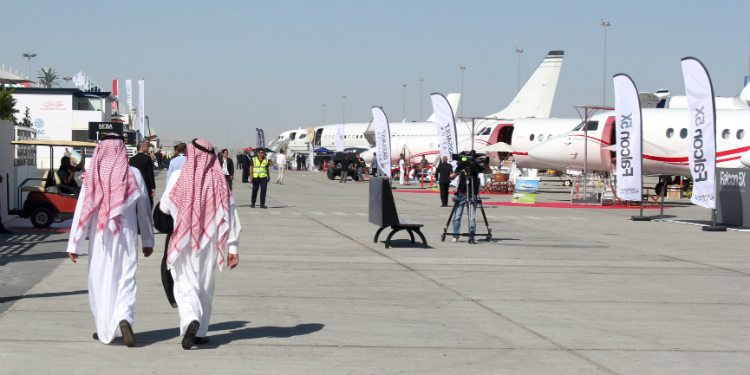Middle East business aviation: large cabins and slow sales

Attendees at MEBA 2014 in Dubai.
When foreigners think of the Middle East they tend to think of sand dunes and camels. The reality is that the Middle East is a sprawling region with a landmass that is 90 per cent the size of the US and a larger, younger population of 351 million, compared to the 319 million people living in the US.
When you look at the Middle East from this perspective, its business jet fleet, which represents less than 3 per cent of the world’s total, suddenly looks rather underwhelming.
According to Jetnet, a provider of business aircraft market research, there are 575 business jets based in the Middle East. Bombardier expects 380 more new deliveries by 2023, where as North America’s fleet is expected to swell to 12,430 with 4,885 new deliveries in the same period.
“The Middle East is still an emerging market,” says Wassim Saheb, a sales director for Bombardier. “The political situation has been horrible for the past five years.”
Beyond geopolitical problems, a reason for this comparatively muted growth could be explained by the fact that the Middle East was the only region this year where the number of billionaires actually dropped – from 84 to 66 – despite a global increase of 15 per cent, according to Bombardier.
The bigger, the better
The perception of Middle Eastern business aviation is that it is very much driven by ultra-long-range aircraft and lavishly-configured bizliners – and there is some truth in this. Heavy jets account for over 70 per cent of the Middle East fleet, and large jets account for 24 per cent of the deliveries predicted by Bombardier over the next 10 years.
Looking at Jetnet’s data in more detail, the combined Airbus and Boeing fleet makes up 24 per cent of the region’s total fleet. Whereas the Cessna Citation Excel is the best-selling business jet series worldwide, the most popular aircraft in the Middle East is the larger Bombardier Challenger 605, closely following by the Boeing BBJ1.
MUST-READ: Flying by BBJ: From pizza ovens to putting greens
There is also a perception that aircraft buyers in the Middle East are driven by more superficial motivations, with corporate jets used as status symbols rather than business tools.
“A lot of the Middle Eastern buyers want the latest, fadiest thing on the market,” says Brendan Lodge, business development director at JetBrokers. “Cash buyers are more dominant.”
However, as the market matures, buyers are becoming savvier. Dassault sees huge potential for its Falcon jets in the Middle East, where the regions accounts for 20 per cent of Falcon 5X sales globally.
“I recently spoke to a Saudi businessman who was trying to calculate the life cycle costs of an aircraft,” says Olivier Villa, senior vice president, civil aircraft at Dassault. “He looked at the 7X, because he had 7X experience. But he asked what he really needed, which was range, so he is now considering buying the 2000LX until the 5X is available.”
With a higher demand for new aircraft, the pre-owned aircraft market has suffered. Aircraft in the Middle East spend an average of 582 days on the market, which is considerably more than the global average of 391 days last year.
ACJ and BBJs are spending well in excess of one year on the market,” says Scott Plumb, senior vice president for sales at Jetcraft. “Buyers are having to discount these aircraft to below their expectations to get them moving.”
ALSO READ: Airbus continues corporate jet battle with Boeing
It is not only bizliner sales that are dragging. Globally, the Gulfstream G550 inventory almost doubled in the first half of the year and it continues to cause headaches for aircraft brokers.
“One of the toughest markets is the G550, there were seven for sale in December 2014 and there are now 35,” says Thierry Boutsen, president of Boutsen Aviation. However, Steve Varsano, founder of The Jet Business in London, says the number of G550s for sale is still “tiny” and claims “the aircraft has held its value tremendously well.”
Brokers have also struggled to shift Bombardier jets as quickly in the Middle East – as well as other regions – where more than 14 per cent of the Global 5000 fleet is listed for sale, according to Plumb.
ALSO READ: Gulfstream G550 inventory almost doubles
“Roughly, two Global XRS aircraft are selling a month; unless you’re pricing to be one of those two, you’re not going to sell,” says Plumb.
Cultural differences
Some people have speculated that the reason behind the slow sales process in the Middle East could be cultural rather than economic, with Bombardier’s Saheb claiming Middle Eastern aircraft owners are “never happy with the trade-in price” offered to them.
“Sellers in the Middle East prefer a ‘make offer’ rather than putting a price on their aircraft,” says Christopher Zarnik, president of Corporate Concepts. “It means it’s going to stay on the market a lot longer.”
Some of the custom interiors, which are more common in the Middle East than other regions, also have a negative effect on an aircraft’s potential for resale, according to brokers. Lodge adds: “Owners spend a fortune on an interior that no one is prepared to pay for.”









